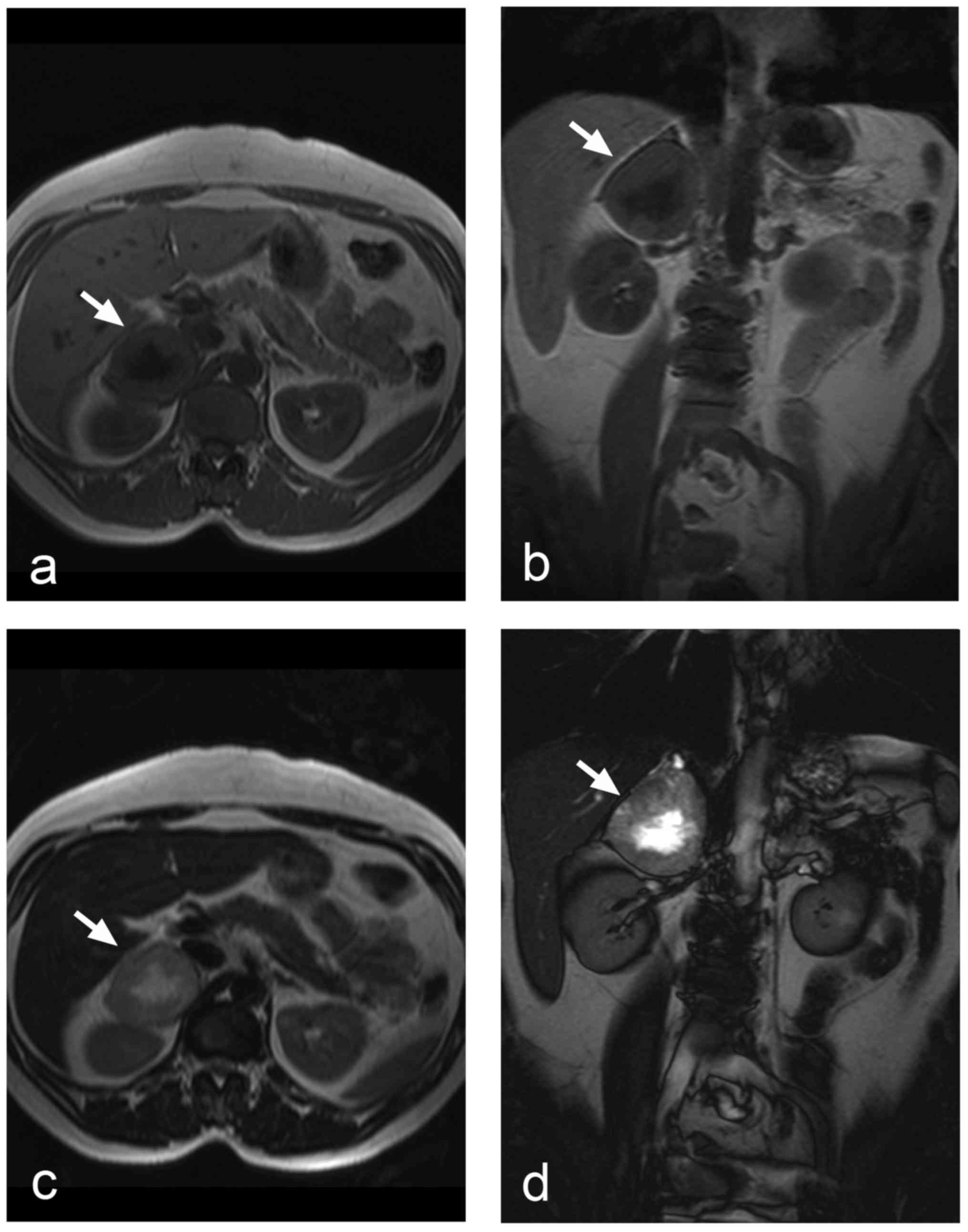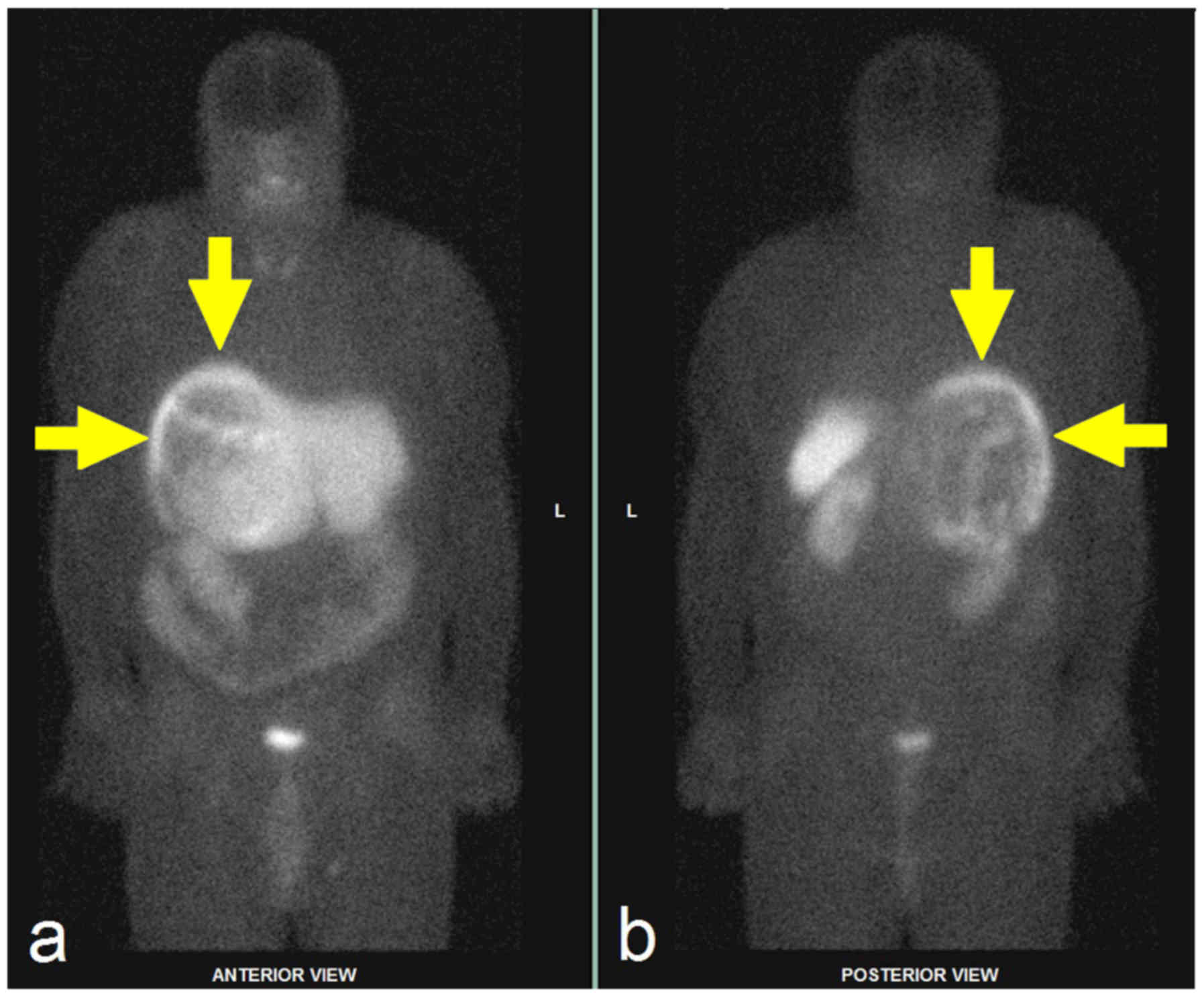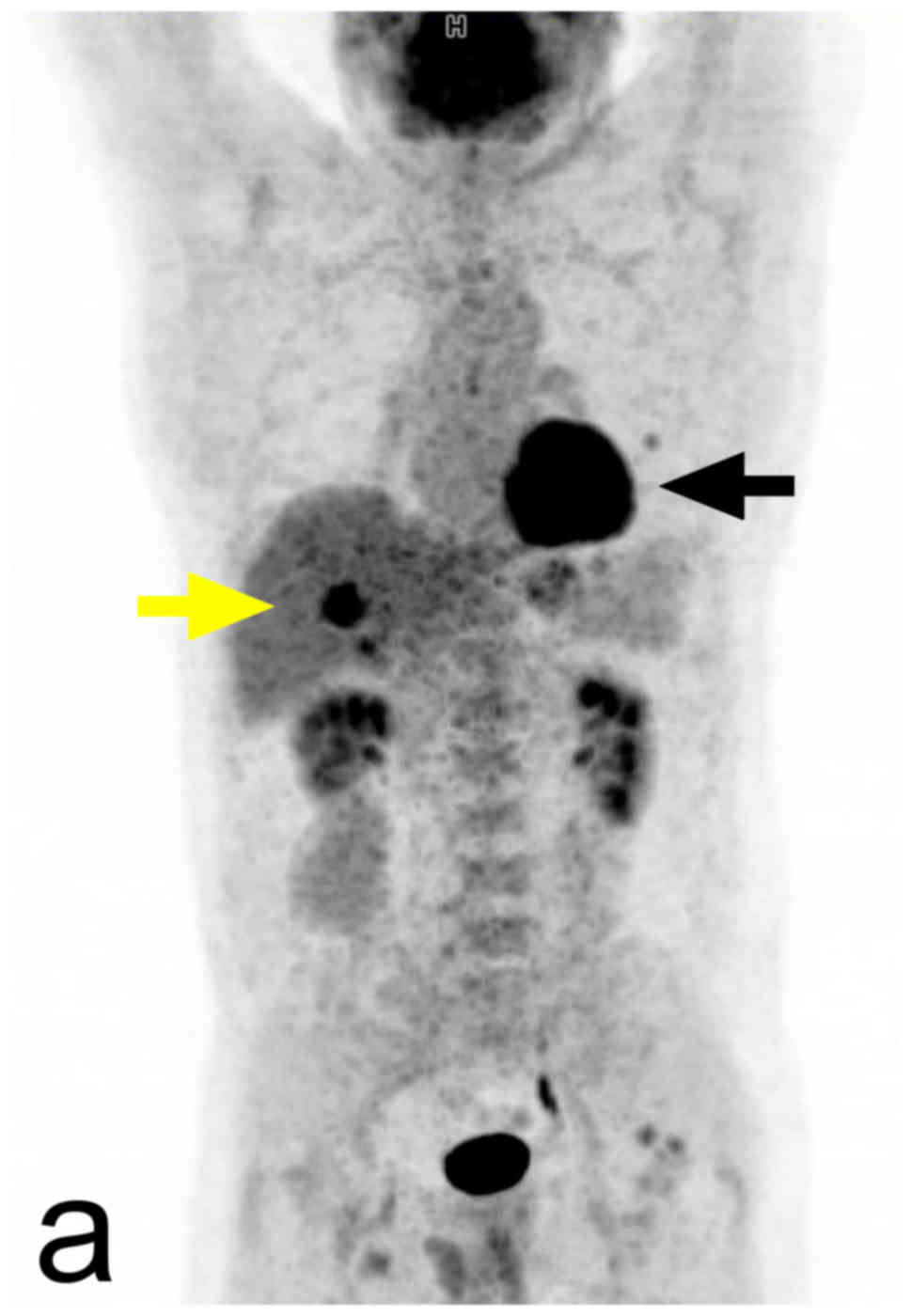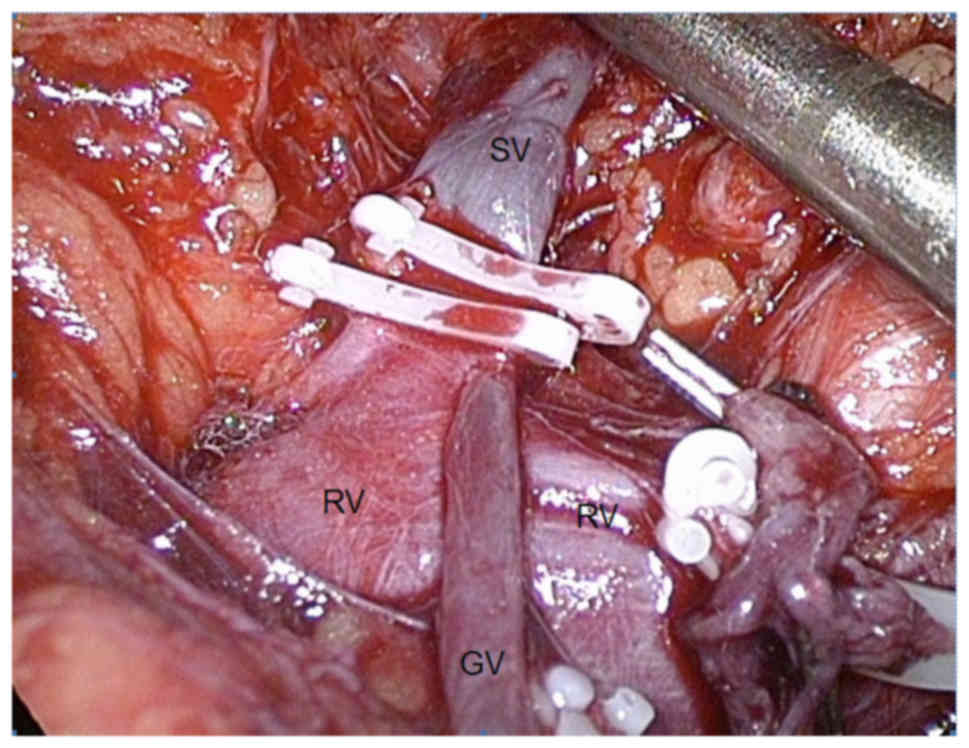Current diagnostic imaging of pheochromocytomas and implications for therapeutic strategy (Review)
- Authors:
- Filip Čtvrtlík
- Pavel Koranda
- Jan Schovánek
- Jozef Škarda
- Igor Hartmann
- Zbyněk Tüdös
-
Affiliations: Department of Radiology, University Hospital and Faculty of Medicine and Dentistry, Palacky University, 779 00 Olomouc, Czech Republic, Department of Nuclear Medicine, University Hospital and Faculty of Medicine and Dentistry, Palacky University, 779 00 Olomouc, Czech Republic, Department of Internal Medicine III‑Nephrology, Rheumatology and Endocrinology, University Hospital and Faculty of Medicine and Dentistry, Palacky University, 779 00 Olomouc, Czech Republic, Department of Clinical and Molecular Pathology, University Hospital and Faculty of Medicine and Dentistry, Palacky University, 779 00 Olomouc, Czech Republic, Department of Urology, University Hospital and Faculty of Medicine and Dentistry, Palacky University, 779 00 Olomouc, Czech Republic - Published online on: February 14, 2018 https://doi.org/10.3892/etm.2018.5871
- Pages: 3151-3160
-
Copyright: © Čtvrtlík et al. This is an open access article distributed under the terms of Creative Commons Attribution License.
This article is mentioned in:
Abstract
 |
 |
 |
 |
 |
 |
 |
 |
|
Dahia PL: Pheochromocytoma and paraganglioma pathogenesis: Learning from genetic heterogeneity. Nat Rev Cancer. 14:108–119. 2014. View Article : Google Scholar : PubMed/NCBI | |
|
Lenders JW, Eisenhofer G, Mannelli M and Pacak K: Phaeochromocytoma. Lancet. 366:665–675. 2005. View Article : Google Scholar : PubMed/NCBI | |
|
Lam AK: Update on adrenal tumours in 2017 world health organization (WHO) of endocrine tumours. Endocr Pathol. 28:213–227. 2017. View Article : Google Scholar : PubMed/NCBI | |
|
Lloyd RV, Osamura RY, Klöppel G and Rosai J: WHO Classification of Tumours of Endocrine Organs. 4th. IACR; Lyon: 2017 | |
|
Roman-Gonzalez A and Jimenez C: Malignant pheochromocytoma-paraganglioma: Pathogenesis, TNM staging and current clinical trials. Curr Opin Endocrinol Diabetes Obes. 24:174–183. 2017. View Article : Google Scholar : PubMed/NCBI | |
|
Amin B, Edge S and Greene F: AJCC cancer staging manual. Springer; New York: 2017, View Article : Google Scholar | |
|
Lenders JW, Duh QY, Eisenhofer G, Gimenez-Roqueplo AP, Grebe SK, Murad MH, Naruse M, Pacak K and Young WF Jr; Endocrine Society, : Pheochromocytoma and paraganglioma: An endocrine society clinical practice guideline. J Clin Endocrinol Metab. 99:1915–1942. 2014. View Article : Google Scholar : PubMed/NCBI | |
|
Crona J, Taïeb D and Pacak K: New perspectives on pheochromocytoma and paraganglioma: Towards a molecular classification. Endocr Rev. 38:489–515. 2017. View Article : Google Scholar : PubMed/NCBI | |
|
Pacak K and Del Rivero J: Pheochromocytoma (Updated June 10, 2013) = Endotext. De Groot LJ, Chrousos G, Dungan K, Feingold KR, Grossman A, Hershman JM, Koch C, Korbonits M, McLachlan R, New M, et al: MDText.com, Inc.; South Dartmouth, MA: 2000 | |
|
Neumann HP, Bausch B, McWhinney SR, Bender BU, Gimm O, Franke G, Schipper J, Klisch J, Altehoefer C, Zerres K, et al: Germ-line mutations in nonsyndromic pheochromocytoma. N Engl J Med. 346:1459–1466. 2002. View Article : Google Scholar : PubMed/NCBI | |
|
Pacak K and Wimalawansa SJ: Pheochromocytoma and paraganglioma. Endocr Pract. 21:406–412. 2015. View Article : Google Scholar : PubMed/NCBI | |
|
Qin Y, Yao L, King EE, Buddavarapu K, Lenci RE, Chocron ES, Lechleiter JD, Sass M, Aronin N, Schiavi F, et al: Germline mutations in TMEM127 confer susceptibility to pheochromocytoma. Nat Genet. 42:229–233. 2010. View Article : Google Scholar : PubMed/NCBI | |
|
Tsirlin A, Oo Y, Sharma R, Kansara A, Gliwa A and Banerji MA: Pheochromocytoma: A review. Maturitas. 77:229–238. 2014. View Article : Google Scholar : PubMed/NCBI | |
|
Baysal BE, Ferrell RE, Willett-Brozick JE, Lawrence EC, Myssiorek D, Bosch A, van der Mey A, Taschner PE, Rubinstein WS, Myers EN, et al: Mutations in SDHD, a mitochondrial complex II gene, in hereditary paraganglioma. Science. 287:848–851. 2000. View Article : Google Scholar : PubMed/NCBI | |
|
Niemann S and Müller U: Mutations in SDHC cause autosomal dominant paraganglioma, type 3. Nat Genet. 26:268–270. 2000. View Article : Google Scholar : PubMed/NCBI | |
|
Astuti D, Latif F, Dallol A, Dahia PL, Douglas F, George E, Sköldberg F, Husebye ES, Eng C and Maher ER: Gene mutations in the succinate dehydrogenase subunit SDHB cause susceptibility to familial pheochromocytoma and to familial paraganglioma. Am J Hum Genet. 69:49–54. 2001. View Article : Google Scholar : PubMed/NCBI | |
|
Karasek D, Shah U, Frysak Z, Stratakis C and Pacak K: An update on the genetics of pheochromocytoma. J Hum Hypertens. 27:141–147. 2013. View Article : Google Scholar : PubMed/NCBI | |
|
Brouwers FM, Eisenhofer G, Tao JJ, Kant JA, Adams KT, Linehan WM and Pacak K: High frequency of SDHB germline mutations in patients with malignant catecholamine-producing paragangliomas: Implications for genetic testing. J Clin Endocrinol Metab. 91:4505–4509. 2006. View Article : Google Scholar : PubMed/NCBI | |
|
Fishbein L, Leshchiner I, Walter V, Danilova L, Robertson AG, Johnson AR, Lichtenberg TM, Murray BA, Ghayee HK, Else T, Ling S, et al: Comprehensive molecular characterization of pheochromocytoma and paraganglioma. Cancer Cell. 31:181–193. 2017. View Article : Google Scholar : PubMed/NCBI | |
|
NGS, in PPGL (NGSnPPGL) Study Group, ; Toledo RA, Burnichon N, Cascon A, Benn DE, Bayley JP, Welander J, Tops CM, Firth H, Dwight T, et al: Consensus statement on next-generation-sequencing-based diagnostic testing of hereditary phaeochromocytomas and paragangliomas. Nat Rev Endocrinol. 13:233–247. 2017. View Article : Google Scholar : PubMed/NCBI | |
|
Zelinka T and Widimský J: Pheochromocytoma-why is its early diagnosis so important for patient? Vnitr Lek. 61:487–491. 2015.PubMed/NCBI | |
|
Pacak K, Linehan WM, Eisenhofer G, Walther MM and Goldstein DS: Recent advances in genetics, diagnosis, localization and treatment of pheochromocytoma. Ann Intern Med. 134:315–329. 2001. View Article : Google Scholar : PubMed/NCBI | |
|
Chen H, Sippel RS, O'Dorisio MS, Vinik AI, Lloyd RV and Pacak K; North American Neuroendocrine Tumor Society (NANETS), : The North American neuroendocrine tumor society consensus guideline for the diagnosis and management of neuroendocrine tumors: Pheochromocytoma, paraganglioma and medullary thyroid cancer. Pancreas. 39:775–783. 2010. View Article : Google Scholar : PubMed/NCBI | |
|
Lenders JW, Pacak K, Walther MM, Linehan WM, Mannelli M, Friberg P, Keiser HR, Goldstein DS and Eisenhofer G: Biochemical diagnosis of pheochromocytoma: Which test is best? JAMA. 287:1427–1434. 2002. View Article : Google Scholar : PubMed/NCBI | |
|
Eisenhofer G, Siegert G, Kotzerke J, Bornstein SR and Pacak K: Current progress and future challenges in the biochemical diagnosis and treatment of pheochromocytomas and paragangliomas. Horm Metab Res. 40:329–337. 2008. View Article : Google Scholar : PubMed/NCBI | |
|
Eisenhofer G, Goldstein DS, Walther MM, Friberg P, Lenders JW, Keiser HR and Pacak K: Biochemical diagnosis of pheochromocytoma: How to distinguish true-from false-positive test results. J Clin Endocrinol Metab. 88:2656–2666. 2003. View Article : Google Scholar : PubMed/NCBI | |
|
Jacques AE, Sahdev A, Sandrasagara M, Goldstein R, Berney D, Rockall AG, Chew S and Reznek RH: Adrenal phaeochromocytoma: Correlation of MRI appearances with histology and function. Eur Radiol. 18:2885–2892. 2008. View Article : Google Scholar : PubMed/NCBI | |
|
Motta-Ramirez GA, Remer EM, Herts BR, Gill IS and Hamrahian AH: Comparison of CT Findings in symptomatic and incidentally discovered pheochromocytomas. Am J Roentgenol. 185:684–688. 2005. View Article : Google Scholar | |
|
Čtvrtlík F, Heřman M, Študent V, Tichá V and Minařík J: Differential diagnosis of incidentally detected adrenal masses revealed on routine abdominal CT. Eur J Radiol. 69:243–252. 2009. View Article : Google Scholar : PubMed/NCBI | |
|
Patel J, Davenport MS, Cohan RH and Caoili EM: Can established CT attenuation and washout criteria for adrenal adenoma accurately exclude pheochromocytoma? AJR Am J Roentgenol. 201:122–127. 2013. View Article : Google Scholar : PubMed/NCBI | |
|
Schieda N, Alrashed A, Flood TA, Samji K, Shabana W and McInnes MD: Comparison of quantitative MRI and CT washout analysis for differentiation of adrenal pheochromocytoma from adrenal adenoma. AJR Am J Roentgenol. 206:1141–1148. 2016. View Article : Google Scholar : PubMed/NCBI | |
|
Zhang GM, Shi B, Sun H, Jin ZY and Xue HD: Differentiating pheochromocytoma from lipid-poor adrenocortical adenoma by CT texture analysis: Feasibility study. Abdom Radiol. 42:2305–2313. 2017. View Article : Google Scholar | |
|
McDermott S, McCarthy CJ and Blake MA: Images of pheochromocytoma in adrenal glands. Gland Surg. 4:350–358. 2015.PubMed/NCBI | |
|
Pacak K, Goldstein DS, Doppman JL, Shulkin BL, Udelsman R and Eisenhofer G: A ‘pheo’ lurks: Novel approaches for locating occult pheochromocytoma. J Clin Endocrinol Metab. 86:3641–3646. 2001. View Article : Google Scholar : PubMed/NCBI | |
|
Korobkin M, Giordano TJ, Brodeur FJ, Francis IR, Siegelman ES, Quint LE, Dunnick NR, Heiken JP and Wang HH: Adrenal adenomas: Relationship between histologic lipid and CT and MR findings. Radiology. 200:743–747. 1996. View Article : Google Scholar : PubMed/NCBI | |
|
Remer EM, Motta-Ramirez GA, Shepardson LB, Hamrahian AH and Herts BR: CT histogram analysis in pathologically proven adrenal masses. Am J Roentgenol. 187:191–196. 2006. View Article : Google Scholar | |
|
Lubner MG, Smith AD, Sandrasegaran K, Sahani DV and Pickhardt PJ: CT texture analysis: Definitions, applications, biologic correlates and challenges. RadioGraphics. 37:1483–1503. 2017. View Article : Google Scholar : PubMed/NCBI | |
|
Northcutt BG, Raman SP, Long C, Oshmyansky AR, Siegelman SS, Fishman EK and Johnson PT: MDCT of adrenal masses: Can dual-phase enhancement patterns be used to differentiate adenoma and pheochromocytoma? AJR Am J Roentgenol. 201:834–839. 2013. View Article : Google Scholar : PubMed/NCBI | |
|
Korobkin M, Brodeur FJ, Yutzy GG, Francis IR, Quint LE, Dunnick NR and Kazerooni EA: Differentiation of adrenal adenomas from nonadenomas using CT attenuation values. AJR Am J Roentgenol. 166:531–536. 1996. View Article : Google Scholar : PubMed/NCBI | |
|
Caoili EM, Korobkin M, Francis IR, Cohan RH and Dunnick NR: Delayed enhanced CT of lipid-poor adrenal adenomas. AJR Am J Roentgenol. 175:1411–1415. 2000. View Article : Google Scholar : PubMed/NCBI | |
|
Szolar DH, Korobkin M, Reittner P, Berghold A, Bauernhofer T, Trummer H, Schoellnast H, Preidler KW and Samonigg H: Adrenocortical carcinomas and adrenal pheochromocytomas: Mass and enhancement loss evaluation at delayed contrast-enhanced CT. Radiology. 234:479–485. 2005. View Article : Google Scholar : PubMed/NCBI | |
|
Kumagae Y, Fukukura Y, Takumi K, Shindo T, Tateyama A, Kamiyama T, Kamimura K and Nakajo M: Distinguishing adrenal adenomas from non-adenomas on dynamic enhanced CT: A comparison of 5 and 10 min delays after intravenous contrast medium injection. Clin Radiol. 68:696–703. 2013. View Article : Google Scholar : PubMed/NCBI | |
|
Mukherjee JJ, Peppercorn PD, Reznek RH, Patel V, Kaltsas G, Besser M and Grossman AB: Pheochromocytoma: Effect of nonionic contrast medium in CT on circulating catecholamine levels. Radiology. 202:227–231. 1997. View Article : Google Scholar : PubMed/NCBI | |
|
Bessell-Browne R and O'Malley ME: CT of pheochromocytoma and paraganglioma: Risk of adverse events with i.v. administration of nonionic contrast material. AJR Am J Roentgenol. 188:970–974. 2007. View Article : Google Scholar : PubMed/NCBI | |
|
Mansmann G, Lau J, Balk E, Rothberg M, Miyachi Y and Bornstein SR: The clinically inapparent adrenal mass: Update in diagnosis and management. Endocr Rev. 25:309–340. 2004. View Article : Google Scholar : PubMed/NCBI | |
|
Tsushima Y, Takahashi-Taketomi A and Endo K: Diagnostic utility of diffusion-weighted MR imaging and apparent diffusion coefficient value for the diagnosis of adrenal tumors. J Magn Reson Imaging. 29:112–117. 2009. View Article : Google Scholar : PubMed/NCBI | |
|
Umanodan T, Fukukura Y, Kumagae Y, Shindo T, Nakajo M, Takumi K, Nakajo M, Hakamada H, Umanodan A and Yoshiura T: ADC histogram analysis for adrenal tumor histogram analysis of apparent diffusion coefficient in differentiating adrenal adenoma from pheochromocytoma. J Magn Reson Imaging. 45:1195–1203. 2017. View Article : Google Scholar : PubMed/NCBI | |
|
Dong Y and Liu Q: Differentiation of malignant from benign pheochromocytomas with diffusion-weighted and dynamic contrast-enhanced magnetic resonance at 3.0 T. J Comput Assist Tomogr. 36:361–366. 2012. View Article : Google Scholar : PubMed/NCBI | |
|
Kim S, Salibi N, Hardie AD, Xu J, Lim RP, Lee VS and Taouli B: Characterization of adrenal pheochromocytoma using respiratory-triggered proton MR spectroscopy: Initial experience. AJR Am J Roentgenol. 192:450–454. 2009. View Article : Google Scholar : PubMed/NCBI | |
|
Melo HJ, Goldman SM, Szejnfeld J, Faria JF, Huayllas MK, Andreoni C and Kater CE: Application of a protocol for magnetic resonance spectroscopy of adrenal glands: An experiment with over 100 cases. Radiol Bras. 47:333–341. 2014. View Article : Google Scholar : PubMed/NCBI | |
|
Reimer P, Parizel PM and Stichnoth FA: Clinical MR imaging: A practical approach Second, completely revised and updated. Springer-Verlag; Berlin Heidelberg New York: 2006, View Article : Google Scholar | |
|
Shellock FG and Kanal E: Safety of magnetic resonance imaging contrast agents. J Magn Reson Imaging. 10:477–484. 1999. View Article : Google Scholar : PubMed/NCBI | |
|
Taïeb D, Timmers HJ, Hindié E, Guillet BA, Neumann HP, Walz MK, Opocher G, de Herder WW, Boedeker CC and de Krijger RR: EANM 2012 guidelines for radionuclide imaging of phaeochromocytoma and paraganglioma. Eur J Nucl Med Mol Imaging. 39:1977–1995. 2012. View Article : Google Scholar : PubMed/NCBI | |
|
Bombardieri E, Giammarile F, Aktolun C, Baum RP, Bischof Delaloye A, Maffioli L, Moncayo R, Mortelmans L, Pepe G, Reske SN, et al: 131I/123I-metaiodobenzylguanidine (mIBG) scintigraphy: Procedure guidelines for tumour imaging. Eur J Nucl Med Mol Imaging. 37:2436–2446. 2010. View Article : Google Scholar : PubMed/NCBI | |
|
Treglia G, Cocciolillo F, de Waure C, Di Nardo F, Gualano MR, Castaldi P, Rufini V and Giordano A: Diagnostic performance of 18F-dihydroxyphenylalanine positron emission tomography in patients with paraganglioma: A meta-analysis. Eur J Nucl Med Mol Imaging. 39:1144–1153. 2012. View Article : Google Scholar : PubMed/NCBI | |
|
Fiebrich HB, Brouwers AH, Kerstens MN, Pijl ME, Kema IP, de Jong JR, Jager PL, Elsinga PH, Dierckx RA, van der Wal JE, et al: 6-(F-18)Fluoro-l-dihydroxyphenylalanine positron emission tomography is superior to conventional imaging with 123I-metaiodobenzylguanidine scintigraphy, computer tomography and magnetic resonance imaging in localizing tumors causing catecholamine excess. J Clin Endocrinol Metab. 94:3922–3930. 2009. View Article : Google Scholar : PubMed/NCBI | |
|
Timmers HJ, Chen CC, Carrasquillo JA, Whatley M, Ling A, Eisenhofer G, King KS, Rao JU, Wesley RA, Adams KT and Pacak K: Staging and functional characterization of pheochromocytoma and paraganglioma by 18F-fluorodeoxyglucose (18F-FDG) positron emission tomography. J Natl Cancer Inst. 104:700–708. 2012. View Article : Google Scholar : PubMed/NCBI | |
|
Janssen I, Chen CC, Millo CM, Ling A, Taieb D, Lin FI, Adams KT, Wolf KI, Herscovitch P, Fojo AT, et al: PET/CT comparing (68)Ga-DOTATATE and other radiopharmaceuticals and in comparison with CT/MRI for the localization of sporadic metastatic pheochromocytoma and paraganglioma. Eur J Nucl Med Mol Imaging. 43:1784–1791. 2016. View Article : Google Scholar : PubMed/NCBI | |
|
Jing H, Li F, Wang L, Wang Z, Li W, Huo L and Zhang J: Comparison of the 68Ga-DOTATATA PET/CT, FDG PET/CT and MIBG SPECT/CT in the evaluation of suspected primary pheochromocytomas and paragangliomas. Clin Nucl Med. 42:525–529. 2017. View Article : Google Scholar : PubMed/NCBI | |
|
Chang CA, Pattison DA, Tothill RW, Kong G, Akhurst TJ, Hicks RJ and Hofman MS: 68Ga-DOTATATE and 18F-FDG PET/CT in paraganglioma and pheochromocytoma: Utility, patterns and heterogeneity. Cancer Imaging. 16:2016. View Article : Google Scholar : PubMed/NCBI | |
|
Tato A, Orte L, Diz P, Quereda C and Ortuno J: Malignant pheochromocytoma, still a therapeutic challenge. Am J Hypertens. 10:479–481. 1997. View Article : Google Scholar : PubMed/NCBI | |
|
Strong VE, Kennedy T, Al-Ahmadie H, Tang L, Coleman J, Fong Y, Brennan M and Ghossein RA: Prognostic indicators of malignancy in adrenal pheochromocytomas: Clinical, histopathologic and cell cycle/apoptosis gene expression analysis. Surgery. 143:759–768. 2008. View Article : Google Scholar : PubMed/NCBI | |
|
Thompson LD: Pheochromocytoma of the adrenal gland scaled score (PASS) to separate benign from malignant neoplasms: A clinicopathologic and immunophenotypic study of 100 cases. Am J Surg Pathol. 26:551–566. 2002. View Article : Google Scholar : PubMed/NCBI | |
|
Mlika M, Kourda N, Zorgati MM, Bahri S, Ben Ammar S and Zermani R: Prognostic value of Pheochromocytoma of the adrenal gland scaled score (Pass score) tests to separate benign from malignant neoplasms. Tunis Med. 91:209–215. 2013.PubMed/NCBI | |
|
de Wailly P, Oragano L, Radé F, Beaulieu A, Arnault V, Levillain P and Kraimps JL: Malignant pheochromocytoma: New malignancy criteria. Langenbecks Arch Surg. 397:239–246. 2012. View Article : Google Scholar : PubMed/NCBI | |
|
Duregon E, Volante M, Bollito E, Goia M, Buttigliero C, Zaggia B, Berruti A, Scagliotti GV and Papotti M: Pitfalls in the diagnosis of adrenocortical tumors: A lesson from 300 consultation cases. Hum Pathol. 46:1799–1807. 2015. View Article : Google Scholar : PubMed/NCBI | |
|
Ctvrtlik F, Koranda P and Tichy T: Adrenal disease: A clinical update and overview of imaging. Biomed Pap Med Fac Univ Palacky Olomouc Czech Repub. 158:23–34. 2014.PubMed/NCBI | |
|
Hodin R, Lubitz C, Phitayakorn R and Stephen A: Diagnosis and management of pheochromocytoma. Curr Probl Surg. 51:151–187. 2014. View Article : Google Scholar : PubMed/NCBI | |
|
Vanderveen KA, Thompson SM, Callstrom MR, Young WF Jr, Grant CS, Farley DR, Richards ML and Thompson GB: Biopsy of pheochromocytomas and paragangliomas: Potential for disaster. Surgery. 146:1158–1166. 2009. View Article : Google Scholar : PubMed/NCBI | |
|
Brunaud L, Nguyen-Thi PL, Mirallie E, Raffaelli M, Vriens M, Theveniaud PE, Boutami M, Finnerty BM, Vorselaars WM, Rinkes IB, et al: Predictive factors for postoperative morbidity after laparoscopic adrenalectomy for pheochromocytoma: A multicenter retrospective analysis in 225 patients. Surg Endosc. 30:1051–1059. 2015. View Article : Google Scholar : PubMed/NCBI | |
|
Perel Y, Schlumberger M, Marguerite G, Alos N, Revillon Y, Sommelet D, De Lumley L, Flamant F, Dyon JF, Lutz P, et al: Pheochromocytoma and paraganglioma in children: A report of 24 cases of the french society of pediatric oncology. Pediatr Hematol Oncol. 14:413–422. 1997. View Article : Google Scholar : PubMed/NCBI | |
|
Wang W, Li P, Wang Y, Wang Y, Ma Z, Wang G, Gao J and Zhou H: Effectiveness and safety of laparoscopic adrenalectomy of large pheochromocytoma: A prospective, nonrandomized, controlled study. Am J Surg. 210:230–235. 2015. View Article : Google Scholar : PubMed/NCBI |









